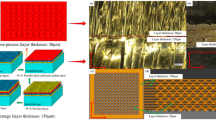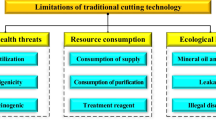Abstract
The core optics in the deep-space high-energy physics ray detection system are an ultra-precision aspherical surface, which would generate surface errors introduced by the ultra-precision single point diamond turning (SPDT), leaving the millimeter-level length and micron-level height periodic mid-spatial frequency (MSF) errors dissatisfying the expected optical performance. Hence, a corrective technique is urgent to effectively remove MSF errors from optical surfaces, enhancing the compliance control of the tool to adapt to curvature-varying optical surfaces to obtain a stable Gaussian-like removal function. This study explored the sponge figuring processing (SFP) removal mechanism, which verified the robustness and removal efficiency of the tool influence function for the planar and various curvatures of the Ni–P surface. To comprehensively investigate the removal function of SFP, based on the sponge-figuring process removal mechanism with three removal regimes, the relative velocity model and contact pressure model are established and verified for validity by pre-experiment. To obtain a stable and effective removal function, L16 orthogonal experiments and analysis of variance (ANOVA) methods were conducted on flat specimen surfaces on a 3-axis ultra-precision figuring tester machine utilizing a sponge head with in-situ correction of high slurry absorption and retention capacity as the figuring tool. To determine the curvature surface impact on the robustness of the tool influence function (TIF), matching experiments of spatial wavelength and full width at half maximum (FWHM) were executed. As a result, the removal function is mainly impacted by the offset, accounting for 40%, and the error was 8% in the predicted value of the volume removal rate under the optimal parameter conditions. From the perspective of optical performance, the significant peak of 1D-power spectral density (PSD) was suppressed in the mid-frequency band, partially converted into high-frequency band errors, and the mid-frequency surface ripple error was effectively enhanced from 2.4 to 1.8 nm, following multiple iterative figuring, for the variable curvature surface.

























Similar content being viewed by others
Abbreviations
- SPDT:
-
Single point diamond turning
- PSD:
-
Power spectral density
- APPP:
-
Atmospheric pressure plasma processing
- LAM:
-
Laser-assisted machining
- FJP:
-
Fluid jet polishing
- MRF:
-
Magneto-rheological finishing
- VAM:
-
Vibration-assisted micro-milling
- SFP:
-
Sponge figuring process
- PSF:
-
Point spread function
- FEA:
-
Finite element analysis
- H-S:
-
Harvey-Shark
- XRS:
-
X-ray scattering
- DT:
-
Diamond turning
- STP:
-
Small tool polishing
- CCOS:
-
Computer-controlled optical surfacing
- MRD:
-
Maximum removal depth
- HSF:
-
High-spatial frequency
- ANOVA:
-
The analysis of variance
- MRR:
-
Material removal rate
- LSF:
-
Low-spatial frequency
- TIF:
-
Tool influence function
- SSD:
-
Suppressed subsurface damage
- BP:
-
Bonnet polishing
- FWHM:
-
The full width at half maximum
References
Mir A, Luo X, Cheng K, Cox A (2018) Investigation of influence of tool rake angle in single point diamond turning of silicon. Int J Adv Manuf Technol 94(5–8):2343–2355
Su X, Yue X (2022) Nonlinear dwell-time algorithm for freeform surface generation by atmospheric-pressure plasma processing. Opt Express 30:18348
Beaucamp A, Namba Y (2013) Super-smooth finishing of diamond turned hard X-ray molding dies by combined fluid jet and bonnet polishing. CIRP Ann 62(1):315–318
Li G, Li Y, Liao Q, Xue J, Wang B (2022) Mechanism of dual-direction vibration-assisted (DVA) micro-milling in surface formation considering the tool life-lengthening effect on the Ti6Al4V: design and experiment. Int J Adv Manuf Technol 123(7–8):2313–2330
Kotha A, Harvey J (1995) Scattering effects of machined optical surfaces. Proc SPIE 2541:54–65
Harvey JE (1995) Scattering effects in x-ray imaging systems. Proc SPIE 2515:246–272
Sironi G, Spiga D (2008) Surface roughness evaluation on mandrels and mirror shells for future X-ray telescopes. Proc SPIE 7011:701137
Zhang H, Zhang N, Han W, Gilchrist MD, Fang F (2021) Investigation on a novel in-mould microcompression system for the precision replication of microlens arrays. J Manuf Processes 67:388–405
Abrahams P (1994) Henry Fitz: A preeminent 19th century telescope maker. J Antique Telescope Soc 6:6–10
Karci Ö, Beldek TB (2021) Quantitative investigation of abrasive grit size dependency of subsurface damages for the metal-bonded abrasives on Zerodur glass-ceramic. Appl Opt 60:2624–2632
Fess E, Ross J, Matthews G (2017) Grinding and polishing of conformal windows and domes. Proc SPIE 10179:101790Q
Davis J, Champey P, Kolodziejczak J, Griffith C (2019) Deterministic polishing of replicating grazing-incidence mandrels. Proc SPIE 11119:111190U
Preston F (1927) The theory and design of plate glass polishing machines. J Glass Technol 11(44):214–256
Luo J, Dornfeld DA (2001) Material removal mechanism in chemical mechanical polishing: theory and modeling. IEEE Trans Semicond Manuf 14:112–133
Evans CJ, Paul E, Dornfeld D, Lucca DA, Byrne G, Tricard M, Klocke F, Dambon O, Mullany BA (2003) Material removal mechanisms in lapping and polishing. CIRP Ann 52(2):611–633
Pan R, Zhong B, Chen D, Wang Z, Fan J, Zhang C, Wei S (2018) Modification of tool influence function of bonnet polishing based on interfacial friction coefficient. Int J Mach Tool Manuf 124:43–52
Schinhaerl M, Rascher R, Stamp R, Smith L, Smith G, Sperber P, Pitschke E (2008) Utilisation of time-variant influence functions in the computer controlled polishing. Precis Eng 32(1):47–54
H. Li, G. Yu, D. Walker, R. Evans (2011) Modelling and measurement of polishing tool influence functions for edge control. JEOS:RP 6:11048.
Wan S, Zhang X, Zhang H, Xu M, Jiang X (2018) Modeling and analysis of sub-aperture tool influence functions for polishing curved surfaces. Precis Eng 51:415–425
Ren L, Zhang G, Zhang L, Zhang Z, Huang Y (2019) Modelling and investigation of material removal profile for computer controlled ultra-precision polishing. Precis Eng 55:144–153
Walker DD, Baldwin A, Evans R, Freeman R, Wei X, Yu G (2007) A quantitative comparison of three grolishing techniques for the Precessions process. Proc SPIE 6671:66711H
Yu G, Reynolds C, Walker D, Fahnle O (2019) Study of footprint variations of CCP considering machine kinematics. EPJ Web Conf 215(24):05004
A. Beaucamp, A. Matsumoto, Y. Namba (2010) Ultra-precision polishing by fluid jet and bonnet polishing for next generation hard X-ray telescope application. Proceedings–ASPE 2010 Annual Meeting 3184.
Civitani MM, Parodi G, Vecchi G, Ghigo M, Basso S, Davis JM, Elsner RF, Kiranmayee K, Pareschi G, Swartz D, Toso G (2019) Lynx x-ray optics based on thin monolithic shells: design and development. J Astronomical Telescopes, Instruments, Systems 5(2):021014
Cheung CF, Lee WB (2001) Characterisation of nanosurface generation in single-point diamond turning. Int J Mach Tool Manuf 41(6):851–875
Goel S, Luo X, Reuben RL (2012) Molecular dynamics simulation model for the quantitative assessment of tool wear during single point diamond turning of cubic silicon carbide. Comput Mater Sci 51(1):402–408
Tauhiduzzaman M, Veldhuis SC (2014) Effect of material microstructure and tool geometry on surface generation in single point diamond turning. Precis Eng 38(3):481–491
Fan P, Katiyar NK, Goel S, He Y, Geng Y, Yan Y, Mao H, Luo X (2023) Oblique nanomachining of gallium arsenide explained using AFM experiments and MD simulations. J Manuf Processes 90:125–138
Vernani D, Borghi G, Calegari G, Castelnuovo M, Citterio O, Ferrario I, Grisoni G, Moretti S, Valsecchi G, Brauninger H, Burwitz V, Eder J, Friedrich P, Predehl P (2011) Performance of a mirror shell replicated from a new flight quality mandrel for eROSITA mission. Proc SPIE 8147:814707
Beaucamp A, Freeman R, Morton R, Ponudurai K, Walker DD (2008) Removal of diamond-turning signatures on x-ray mandrels and metal optics by fluid-jet polishing. Proc SPIE 7018:701835
Dumas P, Golini D, Tricard M (2005) Improvement of figure and finish of diamond turned surfaces with magneto-rheological finishing (MRF). SPIE, Proc, p 5786
Harvey JE, Thompson AK (1995) Scattering effects from residual optical fabrication errors. Proc SPIE 2576:155–174
Wang C, Cheng K, Rakowski R, Soulard J (2018) An experimental investigation on ultra-precision instrumented smart aerostatic bearing spindle applied to high speed micro-drilling. J Manuf Processes 31:324–335
Shang Y, Cheng K, Ding H, Chen S (2022) Design and optimization of the surface texture at the hydrostatic bearing and the spindle for high precision machining. Machines 10(9):806
Su X, Ji P, Jin Y, Li D, Walker D, Yu G, Li H, Wang B (2019) Simulation and experimental study on form-preserving capability of bonnet polishing for complex freeform surfaces. Precis Eng 60:54–62
Khaghani A, Cheng K (2020) Investigation on an innovative approach for clamping contact lens mould inserts in ultraprecision machining using an adaptive precision chuck and its application perspectives. Int J Adv Manuf Technol 111:839–850
Funding
This research was funded by the Key Laboratory of Advanced Manufacturing by Intelligent Technology of the Ministry of Education.
Author information
Authors and Affiliations
Contributions
All authors contributed in all tasks during the research process and the writing of this paper.
Corresponding authors
Ethics declarations
Ethics approval
Not applicable.
Consent to participate
I agree to participate.
Consent for publication
I agree to publish.
Competing interests
The authors declare no competing interests.
Additional information
Publisher's Note
Springer Nature remains neutral with regard to jurisdictional claims in published maps and institutional affiliations.
Rights and permissions
Springer Nature or its licensor (e.g. a society or other partner) holds exclusive rights to this article under a publishing agreement with the author(s) or other rightsholder(s); author self-archiving of the accepted manuscript version of this article is solely governed by the terms of such publishing agreement and applicable law.
About this article
Cite this article
Li, Y., Li, G., Xue, J. et al. Mechanism of a deterministic sponge figuring processing (SFP) in Ni–P surface formation considering the robustness of the tool influence function: modeling and experimental investigation. Int J Adv Manuf Technol 130, 5563–5589 (2024). https://doi.org/10.1007/s00170-024-13008-w
Received:
Accepted:
Published:
Issue Date:
DOI: https://doi.org/10.1007/s00170-024-13008-w




